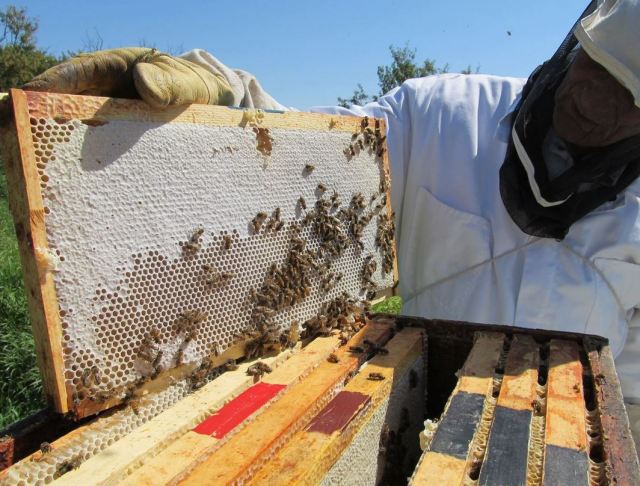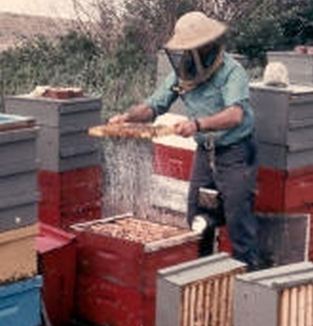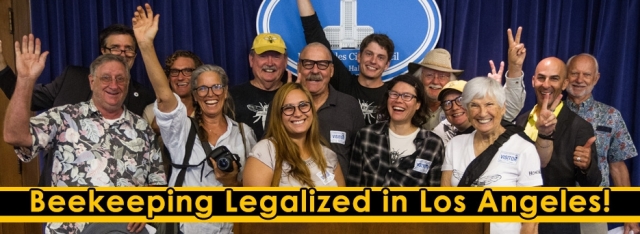
Jacques with honey that’s ripe for extracting.
Occasionally, we take honey from the hive too early. It’s bad honey – some beekeepers call it “green”. High in moisture, and maybe not fully enzymatically converted by the bees. Nectar is ‘wet’ – sometimes 90% water and just 10% sugars. Also, some varieties of flowers have really high sucrose levels – bees add enzymes to reduce the disaccharides (sucrose) into monosaccharides (fructose and glucose), turning nectar into honey. Honey is not honey if the bees haven’t finished drying out nectar’s excess moisture or if the enzymes added by bees have not finished hydrolysizing the sucrose.
Beekeepers dread pulling immature honey from their hives. I’ve been in shops where dehumidifiers are roaring, blasting hot dry air at supers stacked in staggered piles so that the honey gives up some of its excess water. Sometimes high-moisture honey is blended with appropriately dry honey to come up with a product that meets honey’s definition – 18.6% moisture or less. Canadian and American beekeepers hate the extra work and especially hate the inferior product that results, so dehumidifiers are rare and the problem is usually fixed by leaving honey on hives until it’s ready. But surprisingly, wet honey seems to be a business model in parts of China.

Nectar, splashing from a brood chamber frame
Traditionally, Chinese beekeepers have kept bees differently than beekeepers in most other parts of the world. Many Chinese do not own supers. Instead, they open the brood chamber and remove frames close to the brood nest where fresh nectar arrives. To your left is a picture which I took years ago near the Montana-Saskatchewan border. Frames taken from the red-coloured brood nests are often very, very wet. (For us, ‘red’ meant STOP). Green boxes were used as supers. Brood nest nectar (from the red boxes) splashes out easily. That’s why we don’t extract from brood chambers. But the Chinese often do. This was noticed in the 1990s when a US Commerce Department study stated:
“Differences in the honey production process between the United States and China have been reported at the extraction stage. As previously mentioned, the beekeeper in the United States employs a hive structure that consists of supers for honey storage, which allows the honey to dry and ripen. In China, beekeepers reportedly do not use supers, and extract honey from the comb on a daily basis, so that the honey is unripe and high in moisture content, which encourages fermentation. Such extracted honey is collected and taken to processing plants for heating and drying, but while such processing may stem fermentation, it cannot reverse the process and, as a result, honey from China may have the bitter taste associated with fermentation.”
Canola and litchi (lychee) honey in China is often pulled aggressively from brood chambers, resulting in ‘honey’ that’s about 30 to 40% water, instead of below 18.6%, which legally defines honey.
To remove the excess water before the stuff ferments and spoils, the liquid is taken to processors who use a vacuum system to dry it until it resembles honey. If you think you’d like to similarly game the system, you can by a vacuum-actuated honey dryer from one of several Chinese equipment manufacturers. I suggest that you don’t do this as your honey won’t be that great and might not be legal. But one Chinese equipment maker tries to tell us:
“1.) This set of Equipment are made of 304 stainless steel, easy to operate, reliable, efficient, vacuum suction honey; and, 2.) They can achieve high vacuum and low concentration temperature is ideal for honey processing equipment.”
The cost is about US$4,000 and handles one drum per hour, so maybe you’ll want to buy several.

As the ad above says, “Once Cooperated, Forever Friend”. I’ll add a corollary: “Once uncooperated, forever foes”. The ad also says “Quality Makes Difference” and that’s why you should avoid Chinese honey. You can see that the problem with Chinese honey extends beyond poisonous agricultural contaminants and adulteration from industrial sugars. It’s a systemic problem. Although Chinese “water honey” might be benign and simply the result of a traditional aversion to multi-stored beehives, the result is not honey. Honey can’t be rushed.
Bees collect nectar (which may be from 20 to 100% sucrose and from 20 to 90% water) and bring it back to the hive for processing and storing by honey bees. Bees add enzymes that reduce the sucrose to simpler and better sugars which toil our bodies less when we use them. But the conversion takes a bit of time. House honey bees share nectar from forager bees and they add catalyst enzymes that transform nectar into honey. Some of the excess moisture is removed in the hive by the bees’ fanning, but the enzyme process that converts sucrose into fructose and glucose is a hydrolysis process – it takes one water molecule to convert each sucrose molecule. So, evaporation is not the whole story and it’s not enough to remove a gallon of water from three gallons of nectar in a vacuum chamber and then sell the stuff as honey.
Fortunately, a new test that uses Nuclear Magnetic Resonance spectroscopy may help detect immature honey. It’s already used to create profiles of what real honey looks like. Of course, this adds another cost to the price of honey. For now, your best defence might be to buy local honey (unless you are in China or some other country that harvests water honey). In most of the rest of the world, beekeepers try to harvest capped honey, properly produced by honey bees.

Well, I don’t agree with the assessment of “Jacque’s” honey frame in the photo being “ripe for extraction” I would never pull a frame with that many cells uncapped. Is that meant to be a joke?
LikeLike
This was a week after the honey flow had ended in late August. When a flow ends, bees continue to dry, cure, and ripen honey but they do NOT continue to cap it – you need an active nectar flow for cappings to be made. Beekeepers need to know the flows in their area and know when the flow finishes. With experience, a beekeeper learns when honey is ready to extract by observing the bees and checking the honey.
LikeLike
HI, this reflects the difference in temperate climate beekeeping and that of Southern Calif where the flows are ongoing, overlapping, and never really stop—this is due to the plethora of exotics from South America, South Africa and Australia which comprise the irrigated garden plantings of the LA basin. We are having some very good rain, however, so the wild areas and native plants will have a bumper crop of flowers for the first time in 7 or 8 years. I take honey often in December and February. But it also depends on the hive—I took 4 deep frames of capped honey from a hive last week to head off swarming. I just got a small swarm on one of my client’s hives on Monday, Jan 17. We also have drone brood and drones all the time. As I have read in temperate climates, there are great flows of particular trees or shrubs or perennials, and when they are over, that’s it.
LikeLiked by 1 person
Thanks! Sounds interesting!
LikeLike
Still, in any case, a interesting story and I will re-post it at our bee club FB site, HoneyLove.org. This situation is awful—the Chinese should be ashamed of such a brutally abusive taking of the brood nest honey, for one thing, and secondly, for peddling a inferior product.
LikeLiked by 2 people
I just checked out HoneyLove.org – I really like your photo on the cheering that beekeeping became legal in L.A.

Hard to believe it was banned. Congratulations!
LikeLike
Thanks, hadn’t heard about this aspect of Chinese honey production. It sounds very hard on the poor Chinese bees.
LikeLiked by 1 person
Recently started reading your blog, and I’m enjoying it immensely. I’d heard all kinds of horror stories about Chinese honey, but I’d never heard about this issue before. Thanks for sharing this information.
LikeLiked by 1 person
Thanks for the kind words and welcome to this site!
Hope you’ll continue to find this blog interesting!
LikeLike
Pingback: One more thing about Chinese honey. . . | Raising Honey Bees
Ron, any geophysicist needs a hobby and, I guess, bee-keeping is your thing. From what I understand, there are many “Connections”–in life, in nature, in reality. Just make sure that your fans are in on when you take your beehives to Silicon Valley.
And thanks for visiting my blog–and following.
LikeLiked by 1 person
Thanks much! I am a geophycisist, but I spent 15 years first as a commercial beekeeper with over a 1000 colonies and produced a good million pounds of food in those days! Also raised and sold a few thousand queen bees and pollinated fruit in the eastern USA. Then I went to the U of Saskatchewan and became a geophysicist. So bees are more than a hobby!
LikeLiked by 1 person
Pingback: One more thing about Chinese honey. . . | Raising Honey Bees
Stumbled on your blog because of searching about chinese beekeeping as I saw a video of how different it seems to be to here in the west. I have no beekeeping experience and would probably start soon so I will be following. Noted that you have a ton of experience and be glad to read more 🙂
LikeLiked by 1 person